Biomechanics
Advanced Biomechanics Research Systems
Increase subject comfort and minimize cumbersome wiring
Comfortable acquisition hardware, industry-leading analysis software
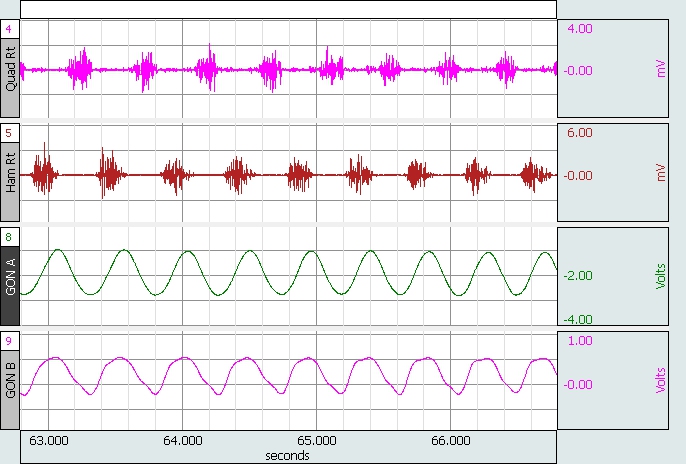
Wired and Wireless Body Movement Data
Now researchers can record body movement data for extended periods or trigger recordings when movement occurs (e.g., karate kick), in both laboratory and field environments, with advanced biomechanical data acquisition and analysis systems from BIOPAC. Input and analyze data from force plates and synchronize measurements with video capture equipment. Scroll through either the physiological data or video and watch the corresponding linked data move to the same location. Perform real-time calculations and post-collection analysis, including X/Y plotting. Use markers to log events as they occur, then add comments immediately or later.
Use a variety of wireless options to provide subjects with a greater degree of freedom, including options for 32 channels of wireless EMG. Track subjects and synchronize the data with GPS to really understand their location and environment. The wireless wearable solutions increase the complexity of experimental design and permit the study of subjects in their natural environment.
Try body movement research tools in the free AcqKnowledge Demo
See More...Hardware Packages | Biomechanics
Hardware Bundles are complete solutions for the specified application. Choose your preferred platform and bundle, then click "Request Pricing" to request an estimate, add/remove items, or complete purchase. If you have questions about specific items, click through to the product web page for details and specifications, or contact your Local Sales contact.
Wired
-
MP160 System + Accelerometer, Goniometer & Heel-Toe Strike
Wired | Biomechanics
MP160 with AcqKnowledge plus 5 g Accelerometer, 110 mm twin-axis Goniometer & Heel-Toe Strike transducer
MP160 System + Accelerometer, Goniometer & Heel-Toe Strike
- 1 x MP160 Data Acquisition Systems
- 1 x Goniometers & Torsiometers
- 1 x Accelerometers
- 2 x General Purpose Transducer Amplifier
- 1 x Heel/Toe Strike Transducer
Wireless
-
BioNomadix Logger with Clench Force & EMG
Wireless | Biomechanics
BioNomadix Logger and one transmitter for wireless dynamometry & EMG, clench force transducer, 30 cm leads & disposable electrodes, plus Impedance Checker
-
MP160 System + wireless Accelerometer, Goniometer & Heel-Toe Strike
Wireless | Biomechanics
MP160 with AcqKnowledge plus BioNomadix wireless accelerometer, goniometer, and heel-toe strike
-
BioNomadix Logger plus Heel/Toe & Goniometry
Wireless | Biomechanics
BioNomadix Logger and three transmitters for wireless accelerometry, goniometry, and heel/toe strike plus goniometer and strike transducers
BioNomadix Logger with Clench Force & EMG
- 1 x BioNomadix Wireless Wearable Physiology Logger
- 1 x BioNomadix Wireless Clench Force Transducer
- 1 x Electrode Leads - BioNomadix Wireless
- 1 x Cloth Base Electrodes
- 1 x Abrasive Pads 10/pk
- 1 x Electrode Impedance Checker
MP160 System + wireless Accelerometer, Goniometer & Heel-Toe Strike
- 1 x MP160 Data Acquisition Systems
- 1 x BioNomadix Wireless Accelerometer Amplifier
- 1 x BioNomadix 2CH Wireless Goniometry Amplifier
- 1 x BioNomadix 2-Ch Wireless Strike Amplifier - Heel/Toe
- 1 x Wireless Heel/Toe Strike Transducer - BioNomadix
- 1 x Wireless Goniometers - BioNomadix
BioNomadix Logger plus Heel/Toe & Goniometry
- 1 x BioNomadix Wireless Wearable Physiology Logger
- 1 x Wireless Heel/Toe Strike Transducer - BioNomadix
- 1 x Wireless Goniometers - BioNomadix
MRI
-
MP160 System with Accelerometer for MRI
MRI | Biomechanics
MP160 System with accelerometer for MRI
MP160 System with Accelerometer for MRI
- 1 x MP160 Data Acquisition Systems
- 1 x Accelerometer 5 G (uses 3 inputs) for MRI
- 1 x MRI Filtered Cable Sets
Details
Available Biomechanics Hardware Solutions Include:
- Mobita– 32 channel wearable biopotential system for wireless live or logged data
- BioNomadix®– Dual Channel wireless physiology amplifiers and data loggers
- CAMSYS– High frame rate, multi subject recording
Featured Biomechanics Applications…
Gait Analysis
Simultaneously acquire up to 16 channels of wireless gait-specific data, including heel-toe, goniometry, accelerometry and more. One setup might incorporate two channels for heel/toe strike timing, ten channels for EMG signals and four channels of goniometry data. Event markers let users log important events in the data and include comments during or post acquisition.
Range Of Motion
Use AcqKnowledge® to determine the velocity of motion occurring during physical activity. All parts of the body can be evaluated for range of motion for purposes of injury assessment or flexibility quantification. Goniometers are available for evaluating one or two degrees of freedom from the same joint (e.g. wrist flexion/extension and radial/ulnar deviations). Use the X/Y plotting feature to inspect motion resulting from two degrees of freedom. Place torsiometers along the spine to measure twisting along the spinal axis. To determine maximum extension and flexion of the digits, place miniature goniometers on the back of fingers. Determine velocity of motion by using AcqKnowledge® to perform a derivative on the recorded movement data, and then run a second derivative on the data to calculate acceleration.
Isometric and Isotonic Contraction
Isolate a wide range of muscle groups and evaluate contraction characteristics. For additional insight, acquire EMG data during isotonic force measurement.
Camera Systems – Multi Subject Video Monitoring![]()
BIOPAC now offers multi-subject video monitoring systems. The new camera systems record multiple subjects and camera angles, and AcqKnowledge® Media functionality synchronizes the video to the data. High frame rate (100 fps), multi-subject, and standard USB cameras triggered by the AcqKnowledge® Stimulator are also supported.
GPS Location
Use AcqKnowledge® to import and synchronize a subject’s physical location with experiment data to provide a log of travel which can then be correlated to the recorded physical responses.
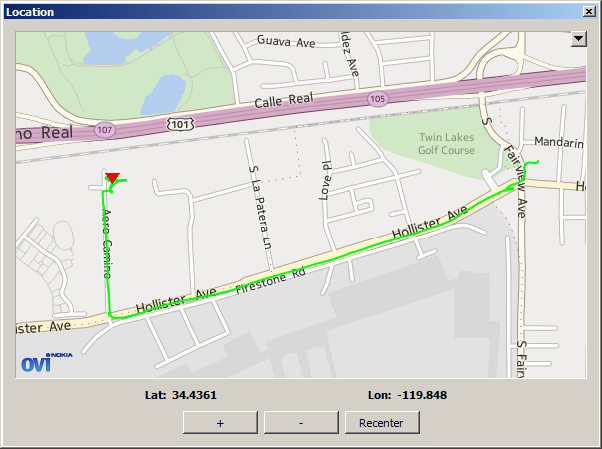
Advanced Features Spotlight
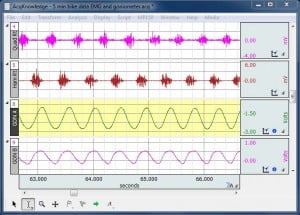
Use AcqKnowledge® to determine the velocity of motion occurring during physical activity. All parts of the body can be evaluated for range of motion. Goniometers are More...
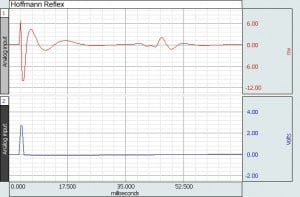
The Hoffmann reflex (H-reflex) is an electrically induced reflex that bypasses the muscle spindle. H-reflex is a useful measure to assess modulation of monosynaptic reflex More...
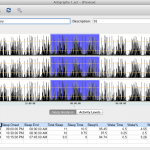
Actigraphy noninvasively measures cycles of activity and sleep (rest) over days or even weeks, typically to assess sleep disorders and other sleep-related criteria. Use the More...
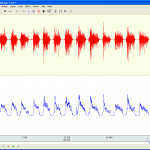
AcqKnowledge includes a number of powerful automated EMG analysis features, including Derive Average Rectified EMG Derive Integrated EMG Root Means Square EMG EMG Frequency & More...
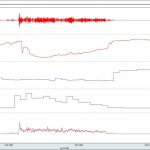
Record microvascular oxygenation during muscle activation Sample Data download → fNIR_EMG.zip (extract biceps_EMG_fnir_demo.acq) Using functional Near Infrared (fNIR) to study muscle function can provide greater understanding of the More...
Videos
Multi-Subject Video Monitoring Systems from BIOPAC
CAM-HFR-A High Frame Rate Camera System
Support
Application Notes
- 101 - Transducer Calibration and Signal Re-Scaling
- 114b - Pneumotach Transducer - TSD107B
- 135 - Pneumotach Transducer - TSD117
- 140 - Goniometers: Angular Measurements
- 154 - High Level Transducer Connections - HLT100C
- 159 - Hand Switch and Foot Switch - TSD116 Series
- 109 - 3-, 6-, and 12-Lead ECG
- 110 - Amplifier Baseline Offset Adjustment
- 126 - Wireless Remote Monitoring - TEL100C-RF
- 136 - Battery Pack Instructions - BAT100
- 162 - Stimulation Features of MP160/150/100 Systems
- 185 - iMac and G3 Compatibility Issues
- 195 - MP System Data Sampling Reference
- 207 - UDP Install: MP150 + No Network Access
- 208 - UDP Install: MP150 + Domain Network Access
- 209 - UDP Install: MP150 + Network Access or Multiple Computers
- 120 - X/Y Loop Area Analysis
- 121 - Waveform Data Reduction
- 122 - Power Spectrum Analysis
- 142 - Rate Detector Algorithm in AcqKnowledge
- 143 - Importing AcqKnowledge Data Into Excel
- 156 - AcqKnowledge File Formats for PC With Windows
- 191 - Digital I/O Channels
- 200 - Creating Arbitrary Waveforms for the MP Systems Stimulator
- 204 - AcqKnowledge Peak Detector Operation
- 218 - Hardware API
- 219 - Known Issues - AcqKnowledge
- 118 - EMG Signal Analysis
- 141 - Tri-Axial Accelerometer Calibration - BSL
- 102 - Biopotential Amplifier Testing With CBLCAL
- 232 - EMG: Normalize to Maximum Voluntary Contraction
- 232 - EMG: Normalize to Maximum Voluntary Contraction - BSL PRO
- 001 - AcqKnowledge Release and OS Compatibility
- 260 - Using Vibromyography to obtain length-tension curves for the quadriceps muscles
- 261 - TSD250 (BPS-II) VMG transducer in the assessment of isometric absolute muscle effort
- 262 - VMG to assess quad-hamstring activity after ACL tear
- 266 - Tri-axial Accelerometer Measurements using BioNomadix
- 268 - Metabolic Analysis Systems and Propane-based Verification
- 270 - Synchronizing Physiology Data Recording with Associated Video
- 273 - Use BioNomadix Accelerometer as Tilt Sensor or Inclinometer
- 275 - Dynamometers for Low Hand Grip Strength Measurements
Knowledge Base
- * CLEANING GUIDELINES *
- AC mode
- AcqKnowledge accuracy
- AcqKnowledge backwards compatibility
- AFT11 Series coupler guide
- Amplifier baseline offset adjustment
- Amplifier conversion - 2 mm to touchproof
- Amplifier filter settings
- Arbitrary waveform stimulation
- Audio recording synchronization
- Band-pass and band-stop filters
- Biopotential amplifier signal validation
- Buffer overflow
- Calculating file sizes
- Calibration values
- Combining Video with AcqKnowledge
- Common mistakes/general troubleshooting
- Connecting Calibration Gas Tanks & Mixing Chambers
- Connecting the TSD116C Switch Box
- Copy and paste append markers along with data
- DA100C amplifier signal validation
- DC mode
- Differences between the NICO100C and EBI100C
- Duplicating waveforms
- ECG Analysis
- ECG artifact in EMG Signal
- ECG R-wave detector
- Editing noisy data
- Electrical stimulation and artifact
- Electrode Properties - gel and adhesive
- Excel files exported from BIOPAC software open in Excel 'Protected View'
- Exporting Data to SPSS
- Extracting data segments from a file
- Extracting heart rate from a noisy ECG signal
- Grounding guidelines
- High pass filters
- IIR vs. FIR filters
- Interfacing third-party transducers
- LabView interface
- Low pass filters
- Magnetic stimulation artifacts
- MP150 UDP protocol fixed IP address
- MRI - Triggering
- Notch filter
- Optimal ground placement
- Outputting a signal through the STM100C
- Physiological measurements - life science signals using BIOPAC
- PPG setup and calibration
- Railing signal (flatline)
- Recording good data
- Respiration recording
- Text files - import and export
- Upgrading from PCMCIA to USB
- USB Drivers and Controller Communication
- Using other software with BIOPAC hardware
- Volume from airflow
- VREF, reference excitation voltage
Stay Connected